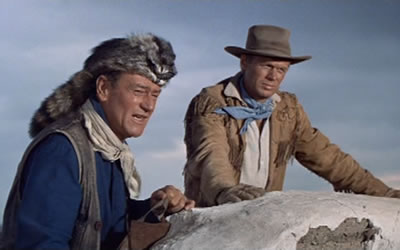This morning I read a 6.9 profile of MGM CEO Gary Barber by Deadline‘s Peter Bart (“A Resurgent MGM Builds Clout For New Film & TV Acquisitions”).
Boiled down it said that Barber doesn’t do interviews but boy, has he turned things around at MGM! Good for MGM stockholders, but to me Barber, his executive accomplishments aside, is still the dick who refused to permit an independent restoration of the 70mm roadshow version of John Wayne‘s The Alamo, and in so doing oversaw its apparent destruction.
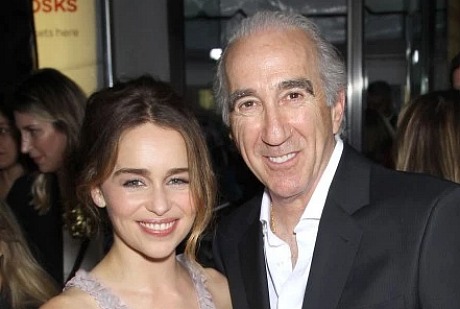
(l.) Me Before You star Emilia Clarke, (r.) MGM CEO Gary Barber at Me Before You premiere at AMC Loews Lincoln Square 13 theater on 5.23.16.
Bart quotes a distribution exec who describes Barber as “a movie fanatic.” No — Barber’s treatment of the 70mm Alamo elements absolutely disqualifies him from ever being so described. What he is, at least in this particular realm and certainly from the perspective of the hovering ghost of Alamo director-producer John Wayne, is a seemingly arrogant egoist, or at the very least a smug one.
“In its own quiet way, MGM produces 5-7 movies a year, has 14 TV shows on the air, has earned a profit of $124 million in its first quarter, and is positioned to make some intriguing acquisitions in the coming year,” Bart wrote. “For a company that five years ago was mired in more than $5 billion in debt and that many in the industry had considered comatose, this is a formidable achievement.”
It seems evident, in short, that outside the Alamo situation Barber is a smart, aggressive, well-organized exec who knows how to get things done. Great. Then why has he shown such callous disregard for the condition of a not-great but generally respected film that could have been saved in its original 70mm form, but is now lost for the most part? What kind of South African buccaneer, unwilling or unable to spend money to restore the 70mm version of a 1960 John Wayne film, refuses to allow a restoration of said film to be independently funded?
It was nearly two years ago when Beverly Faucher, MGM’s VP of Asset Management and Delivery Services, said in an official statement that “the original 65mm theatrical elements of The Alamo are in fine condition and are not in need of restoration” — one of the most outrageously ignorant, bald-faced lies offered by a representative of a Hollywood entertainment company in the history of western civilization.
Faucher declared that “we are currently restoring the additional 20 minutes found in the 70mm ‘roadshow’ version of the film,” and that “once this process is complete, all of the elements of the original content will be intact and there will not be a need for further restoration of the film at this time.”
Leaving aside Faucher’s disinformation, there hasn’t been so much as a peep from MGM in the intervening two years about the release of their Alamo Bluray, which would naturally be the end result of their so-called restoration process.
12.26.14 quote from a “Save The Alamo Facebook page: “Gary Barber is the worst thing to happen to MGM since Jim ‘The Smiling Cobra’ Aubrey systematically sold off the old company in the early 1970’s. Worse, the film library is at stake this time. MGM seems intent on not only having no interest in restoring and preserving [The Alamo], but in actively seeing it destroyed. Unbelievable that this kind of practice is still going on.”
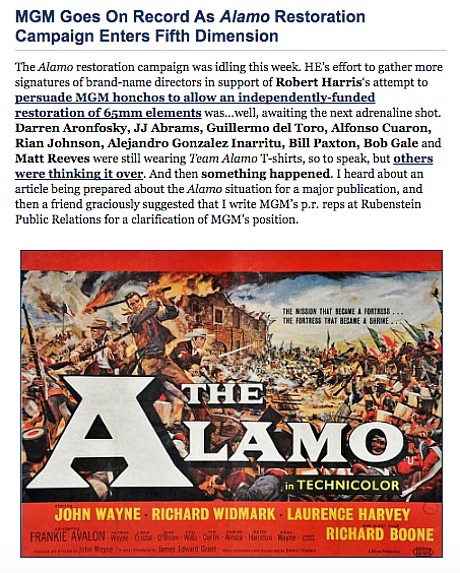
Here’s a portion of a 7.11.14 HE piece called “MGM Goes On Record As Alamo Restoration Campaign Enters Fifth Dimension”:
“After writing MGM’s p.r. reps at Rubenstein Public Relations for a clarification of MGM’s position, the Rubinstein guys passed along an official statement from Beverly Faucher, MGM’s VP of Asset Management and Delivery Services, and here’s what it said:
‘We are proud to say that the original 65 mm theatrical elements of The Alamo are in fine condition and are not in need of restoration. We are currently restoring the additional 20 minutes found in the 70 mm ‘roadshow’ version of the film. Once this process is complete, all of the elements of the original content will be intact and there will not be a need for further restoration of the film at this time.’
“I’m sorry, but as I was reading the above my eyeballs popped out of their sockets and went boiiinnnnggg!
“I sent along Ms. Faucher’s statement to restoration guru Robert Harris, and he replied Wednesday night around 9 pm. For reasons best not explained I decided yesterday morning to hold this article for a day or so, but no longer. Here is Harris’s reply, chapter and verse:
“‘I have no idea where Ms. Faucher is getting her information, but beyond the oddly worded comment of ‘currently restoring the additional 20 minutes’, which I can’t comment upon, not one of her statements rings true.
‘Everything is incorrect.
‘Let’s take her missive one point at a time.
‘The 65mm theatrical elements of The Alamo are some of the worst mid-20th century film elements that I’ve ever had the unfortunate displeasure to examine. This is not opinion. It is fact. And obvious to any archival professional.
‘If she is currently restoring the film to the original ‘roadshow’ version of the film, she is going to find herself short if she is restoring 20 minutes. The original 65mm roadshow version of John Wayne‘s 1960 film, which ran approximately 192 minutes **, was cut by approximately 2,916 feet plus 11 frames. That equates of a running time of approximately 32 minutes, 25 seconds. This would mathematically leave us with a general release print of 159 minutes and 35 seconds, but a myriad of changes (dissolves, recuts, extra shots) put into the general-release version resulted in a running time of 161 minutes. The final difference, therefore, is 31 minutes.
‘But that’s just a running-time issue. Here is the plain, unfettered truth about The Alamo elements:
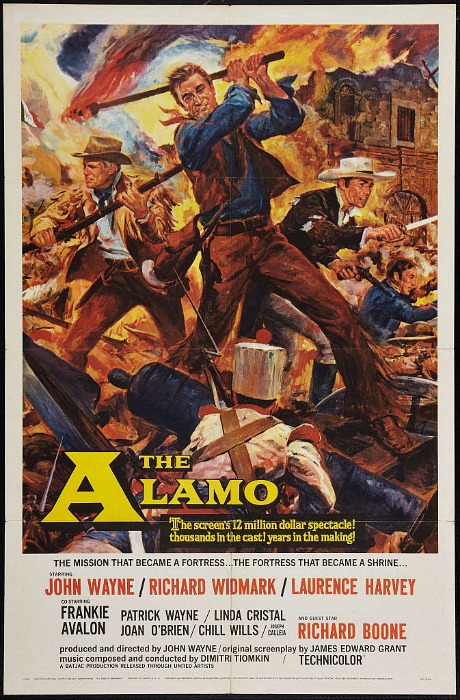
‘The original 65mm camera negative was cut from the 192-minute ‘roadshow’ version ** to the 161-minute general release version, and all trims and deletions were junked, presumably along with original magnetic track stems and trims.
‘The only remaining example of the ‘roadshow’ is a long-faded 70mm print, which was in superb condition when discovered in Toronto in 1992, but then, after being moved to Los Angeles, was taken from its cold storage resting place, and rejuvenated and mishandled toward the production of home video elements.
‘I re-located the Toronto print in 2001 and had MGM move it to cold storage, but the majority of damage had already been done, as it had been stored as a miscellaneous print, after MGM’s mishandling.
‘I inspected the original camera negative of of The Alamo a couple of months ago. The negative is heavily faded in its yellow dye layer down about 70%, with additional fade in the magenta dye layer.
‘When the negative was originally cut and conformed in 1960 at Technicolor, it was cut using black leader that had not been properly washed, and was not chemically inert. The result of this mistake was chemical damage at the head and tail of every shot, appearing as color fluctuations. That damage cuts through the yellow dye layer heavily, and continues in moderation into the magenta dye layer. It is not removable.
‘Additional damage is seen, especially in motion, as a differential fade that moves in and out from both sides of the film, probably entering the image 10% to 15% on each side. It appears to have come from odd oxidation of the stock over the decades, most probably from poor storage in the decades between leaving Technicolor and making its way to its current storage facility. Or possibly due to heat damage.
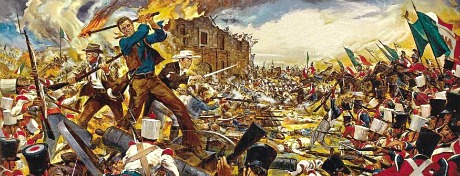
‘As the problems are many, there is no way to simply drop the missing footage back into the general release version of the film, as that version is no longer printable to strike anything near a sufficiently quality-level image.
‘The only element that MGM may have with anything close to decent color remaining would be a 35mm reduction element, which is unsuitable for any kind of restorative consideration, as the resolution of any such element would yield about 25% of the 65mm elements, if they were printable. The 35mm element would also be in the incorrect aspect ratio (i.e., 2.35:1 vs. the 65mm a.r. of 2.21:1).
‘The black & white separation masters have also been cut to the general release version of the film, and have unfortunately been produced slightly out of focus, yielding an image that is not up to large format standards. Tests of recombines have not yielded true large format results.
‘While I’m presuming that Ms. Faucher (or someone else at MGM) has personally examined all of the elements in question and has come away with her appraisal of the situation, it does not mesh in any way with mine.
‘I invite her to examine the elements with me, and to view my tests. If her appraisal is still that the elements are in ‘fine condition,’ God help the rest of the MGM library.
“Lastly, the final verbiage in her statement may be the most frightening, to wit: ‘There will not be a need for further restoration of the film at this time.
‘What she is saying is that she and MGM are going to allow the film to die on their watch. Will MGM permit a process that will lead to The Alamo‘s restoration? Doubtful, as they don’t feel there’s a problem.”
** Wikipedia and other sources have reported that the 1992 Toronto roadshow print of The Alamo ran 202 minutes, not 192 minutes. This discrepancy is due to Dimitri Tiomkin‘s overture, entr’acte and exit music, which were attached to the roadshow version. The overture is 280 feet exactly, which translates to 3.1 minutes as film runs at 90 feet per minute. The Alamo‘s entr’acte music (i.e., played just before Part Two begins) runs 344 feet plus two frames or 3.8 minutes. The exit music runs 300 feet plus one frame, or 3.33 minutes. Grand music total: 10.2 minutes.
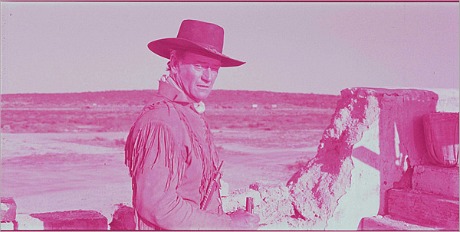
Here’s an HE piece posted on 6.24.14, titled “Gary Barber Cruises Along, Indifferent to Alamo‘s Fate”:
“It’s entirely conceivable that MGM chairman and CEO Gary Barber hasn’t heard about the Alamo situation, and that if someone brought it to his attention he might consider it trivial or irksome. But Barber is the guy in charge (his second-in-commands are MGM motion picture group president Jonathan Glickman, television and digital group president Roma Khanna and CFO Dene B. Stratton) and so we must now delve into Barber’s head as he drives to work in his super-expensive car and talks to himself about the fate of The Alamo‘s 70mm elements. Barber is sipping from a cappucino grande as he cruises down Beverly Glen Blvd. and listens to tunes on Spotify. The time is 8:35 am.
“‘You can watch The Alamo on DVD and on streaming…what’s the problem?,’ Barber says to himself. ‘It wasn’t that great a movie to begin with. Why did I even pledge to spend $5 thousand on restoring the 70mm version anyway? Mr. and Mrs. Joe Popcorn don’t give a shit and frankly neither do I. I have to generate big money for this second-rate company or I’m out on my ass and they want me to pay attention to a 54 year-old John Wayne film that never mattered very much in the first place? Don’t I have enough aggravation?
‘Yeah, I know, I know…all I have to do is say ‘okay, guys…if you can raise the money yourselves you can restore it on your own…no problem and go with God.’ But that will indicate a certain benign weakness on MGM’s part. And that indication will arouse the predatory instincts of MGM’s competitors and then we’ll really be in Shit City, even worse than we are now.
‘A leader like myself must be the Good Shepherd. He must be strong and firm and protect his flock. Maybe that’s the wrong analogy. Maybe MGM needs me to be Don Corleone, and if that’s the case then I know one thing — Don Corleone doesn’t let somebody else restore a family asset.
‘It is a measure of MGM’s power and potency in the marketplace that if we decide to let The Alamo‘s 70mm elements disintegrate into nothingness then we will fucking do that because we are the master of our own universe, and therefore of our own assets. Even if it means the destruction of a moderately respected large-format film, MGM must insist on sailing its own ship, come hell or high water.
‘In order to prove our strength, we must be willing to let Wayne’s 70mm epic die from deterioration. We must be willing, like men, to eliminate it like a farmer must be willing to slit the throat of a lamb. Are we not men? You have to be hard in this world. Sometimes you even have to be cruel.
‘We’re talking about a matter of corporate principle and the perception of virility and conviction. So no offense but honestly? Eff John Wayne, eff the spirit of the Alamo defenders, eff Robert Harris, eff those snooty elites who believe there’s an important difference between a 35mm-sourced DVD image and a 70mm-sourced high-def rendering, eff Chill Wills and Richard Widmark and Laurence Harvey…screw all those guys! I’m alive and I’m they’re not.
‘And double-eff Frankie Avalon! Wait, is Avalon alive? You know what? Eff him either way!” [Wells note: Avalon, 74, is alive and well.]
‘Get this straight — I am Gary effing Barber and nobody but NOBODY tells me what do with my MGM library assets. And if I make a decision that will result in the large-format elements of a 54 year-old film being destroyed for all time to come, then I will damn well do that. Because I can. Because I’m Gary effing Barber and you’re not.’
“In tomorrow’s episode, the ghost of John Wayne hears the Philistine rantings of Gary Barber and swirls down from the heavens and into the plush offices of MGM to have a serious discussion.
“[Beep-beep] Barber: “Yes?” Secretary (on intercom): “Mr. Barber? A Mr. Wayne to see you.” Barber: “Wayne who? Li’l Wayne?” Secretary: “No, sir. His name is John Wayne. He says you know him.” Barber: “I don’t know him and I don’t have time for this. Get rid of him.” Secretary: “He says you do know him, sir.”

